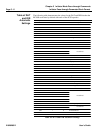
User’s Guide 21020285 D
Chapter 5 Initiator Mode Pass-through Commands
Initiator Pass-through Parameter Block Format Page 5 - 5
Setting DBV,
DAT and DIR
Bits
The DAT and DIR bits, together, indicate whether a data transfer should be
expected for a given command, and if so, which direction it will be: to or from
the target. The DBV bit gates whether the values for DAT and DIR will be
derived from the default table or from the values you assign.
Using the
Table Values
The following table of defaults is useful for you to use when you wish to: 1.)
alter the default behavior of a standard SCSI command for a specific application
or 2.) implement a vendor-unique command.
An example of altering the default function of a command can be demonstrated
with the SCSI Format command. If you examine the DAT, and DIR bit values
for this command in the table, you see that the adapter assumes:
The ones in the table for DIR and DAT mean that by default the adapter will
assume that there is data associated with the command and the direction of data
flow is to the target.
If the Format command for your device requires no data transfer, set the Flags-
1 byte as follows when you issue the Format command:
DBV = 1, DAT = 0, DIR = 0.
Setting DBV to one tells the adapter to examine your settings for DIR and DAT
and their zero settings indicate no data is associated with the command.
An example of the second case, implementing a vendor-unique command, can
also be given. Suppose your SCSI device has a vendor-unique command
available for Opcode 02H. When you examine the table for the default settings
of that opcode you see that the RF3880 adapter assumes:
Note
If you set a combination
of DBV, DIR and DAT
that is inconsistent with
how your target executes
the command, you will
receive error code 24H,
Unexpected SCSI Phase
Encountered. You must
refer to your vendor-
specific documentation
for information about
your peripheral’s
command execution.
In this example, suppose the 02H opcode vendor-unique command involves a
data transfer from the device to the adapter. To override the table values and
use the opcode for a vendor-unique command set the DBV, DAT and DIR bits
of the Flags-1 byte as follows:
DBV = 1; DAT = 1; DIR = 0
This combination means; DBV is set so use Flags-1 field values for DAT and
DIR; DAT is set so data will be transferred; DIR is zero so direction of transfer
is from the device.
Opcode DAT DIR Description
04H 1 1 Format Unit
Table 28: Example DAT and DIR bit settings
Opcode DAT DIR Description
02H 0 0 not defined
Table 29: DIR and DAT Settings, Vendor-unique


















